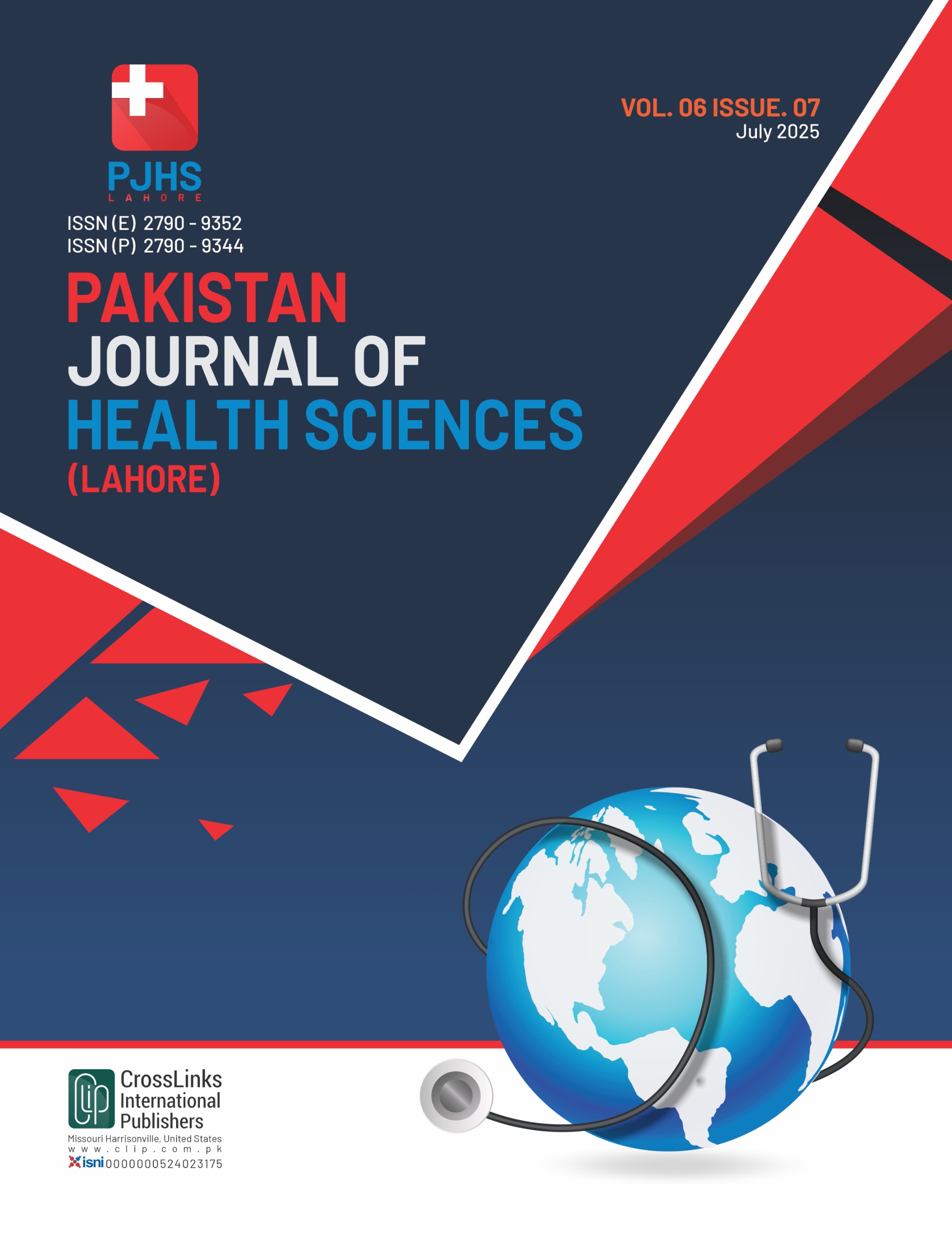Acceptance of Post-Partum Intrauterine Contraceptive Device During Cesarean Section
Post-Partum Intrauterine Contraceptive Device During Cesarean Section
DOI:
https://doi.org/10.54393/pjhs.v6i7.3245Keywords:
Post-Partum Intrauterine Contraceptive Device, Intrauterine Contraceptive Device, Contraception, Cesarean SectionAbstract
The world population is increasing, and approximately 115 million women have unmet needs for family planning. Institutional deliveries are increasing. Institutional deliveries and cesarean sections provide an excellent opportunity to provide women with a long-term, safe, effective and reversible method of contraception in the form of Post-Partum Intrauterine Contraceptive Device (PPIUCD). Objective: To assess the acceptability of PPIUCD as a method of family planning. Methods: A descriptive cross-sectional study was conducted on patients undergoing elective or emergency cesarean sections (C-section) in the Department of Obstetrics and Gynaecology, Social Security Teaching Hospital, Multan Road, Lahore. 116 women were counselled, and in those who opted for it, an IUCD was placed inside the uterus after delivery of the placenta during C-section. This study set 95% confidence (Z=1.96) expected prevalence p from prior literature/pilot, and a conventional margin of error d=0.05 (typical range 0.03–0.05). Where applicable, the study applied finite population correction, then inflated for design effect (if clustered) and 10% nonresponse. Results: Total acceptance rate was 38.79%. The majority of the patients belonged to the age group 19 to 30 years, and the mean age was 30.42 ± 5.28 years. Parity was >2 in 56.9% patients, while in 43.1% parity was ≤2. 24.14% clients were uneducated, and 76.72% belonged to a poor socio-economic group. Conclusions: PPIUCD as inserted during cesarean section is an effective, acceptable and safe method of contraception, with the rate of acceptance of 38.79 %. Previous cesarean history and proper counselling enhance acceptance.
References
Arif M and Gill AR. Socio-Economic Determinants of Urbanization in the Perspective of Pakistan. Pakistan Journal of Humanities and Social Sciences. 2023 Mar; 11(1): 710-7. doi: 10.52131/pjhss.2023.1101.0387. DOI: https://doi.org/10.52131/pjhss.2023.1101.0387
Miladinov G. Socioeconomic Development and Life Expectancy Relationship: Evidence from the EU Accession Candidate Countries. Genus. 2020 Jan; 76(1): 2. doi: 10.1186/s41118-019-0071-0. DOI: https://doi.org/10.1186/s41118-019-0071-0
Hayat A, Nuzhat N, Khalid M, Aslam AS. Factors Affecting Post Placental Intra-Uterine Contraceptive Device Insertion Rate. Biomedica. 2021 Jan; 37(1). doi: 10.51441/BioMedica/5-168. DOI: https://doi.org/10.51441/BioMedica/5-168
Nahas G, Magalhães C, Bueloni-Dias F, Nahas E, Borges V. Immediate Postpartum Insertion of Copper Intrauterine Device in a Brazilian University Hospital: Expulsion and Continuation Rates. Revista Brasileira de Ginecologia e Obstetrícia. 2023 Apr; 45: 31-7. doi: 10.1055/s-0042-1759628. DOI: https://doi.org/10.1055/s-0042-1759628
Tengli S and Deshmukh UB. Efficacy and Satisfaction Rate in Postpartum Intrauterine Contraceptive Device Insertion: A Prospective Study. International Journal of Clinical Obstetrics and Gynaecology. 2021; 5(6): 43-45. doi: 10.33545/gynae.2021.v5.i6a.1056. DOI: https://doi.org/10.33545/gynae.2021.v5.i6a.1056
Armstrong MA, Raine-Bennett T, Reed SD, Gatz J, Getahun D, Schoendorf J et al. Association of the Timing of Postpartum Intrauterine Device Insertion and Breastfeeding with Risks of Intrauterine Device Expulsion. Journal of the American Medical Association Network Open. 2022 Feb; 5(2): e2148474-. doi: 10.1001/jamanetworkopen.2021.48474. DOI: https://doi.org/10.1001/jamanetworkopen.2021.48474
Kanakuze CA, Kaye DK, Musabirema P, Nkubito P, Mbalinda SN. Factors Associated with the Uptake of Immediate Postpartum Intrauterine Contraceptive Devices (PPIUCD) In Rwanda: A Mixed Methods Study. BioMed Central Pregnancy and Childbirth. 2020 Oct; 20(1): 650. doi: 10.1186/s12884-020-03337-5. DOI: https://doi.org/10.1186/s12884-020-03337-5
Kathpalia S. Where Do We Stand a Decade after Introduction of PPIUCD Program? Journal of Clinical Case Studies Reviews and Reports. 2021.
Kutlucan H, Karabacak RO, De Buyser S, Erdem A, Bozkurt N, Demirdağ E et al. Assessment of a Novel Fixation Method of A Frameless Intrauterine Contraceptive Device Inserted During Cesarean Delivery as A Means of Preventing Displacements and Expulsions: A Prospective Observational Study. Life. 2022 Jan; 12(1): 83. doi: 10.3390/life12010083. DOI: https://doi.org/10.3390/life12010083
AR R, Undi M, KG L. A Study to Assess the Perception, Acceptance and Satisfaction Regarding Postpartum Intra Uterine Contraceptive Device Services in a Tertiary Care Hospital in a Coastal District of Karnataka. Indian Journal of Public Health Research and Development. 2025 Jan; 16(1). doi: 10.37506/y72dhm51. DOI: https://doi.org/10.37506/y72dhm51
Kumari AH, Jahangeer SM, Shah M. Acceptance Rate of Post-Partum Intra-Uterine Contraceptive Device and Factors Affecting Its Uptake in A Tertiary Care Hospital in Pakistan. Annals of Abbasi Shaheed Hospital and Karachi Medical and Dental College. 2020; 25(4): 197-203. doi: 10.58397/ashkmdc.v25i4.405. DOI: https://doi.org/10.58397/ashkmdc.v25i4.405
Agrawal S, Induja R, Chopra K, Singh A, Sood S, Puri M. Study of the Client Experience and Continuation Rate of Postpartum Intrauterine Copper-T Device in Semi-Urban Population in India. International Journal of Advanced Medical and Health Research. 2022 Jan; 9(1): 38-41. doi: 10.4103/ijamr.ijamr_212_21. DOI: https://doi.org/10.4103/ijamr.ijamr_212_21
Lichtenstein Liljeblad K, Kopp Kallner H, Brynhildsen J. Risk of Abortion within 1–2 Years After Childbirth in Relation to Contraceptive Choice: A Retrospective Cohort Study. The European Journal of Contraception and Reproductive Health Care. 2020 Mar; 25(2): 141-6. doi: 10.1080/13625187.2020.1718091. DOI: https://doi.org/10.1080/13625187.2020.1718091
Dawoud SE, Abdelwahed AY, Mohamed NH. Effect of Instructional Guidelines On Pregnant Women's Knowledge Regarding Immediate Insertion of an Intrauterine Contraceptive Device During Cesarean Section Versus Late Insertion After the Puerperium. International Journal of Health Sciences. 2021; 5(S1): 636-49. doi: 10.53730/ijhs.v5nS1.13988. DOI: https://doi.org/10.53730/ijhs.v5nS1.13988
Sisay FA, Ayalew AB, Erega BB, Ferede WY. Factors Associated with Knowledge of the Postpartum Intrauterine Contraceptive Device and Attitude Towards Its Use Among Women Attending Antenatal Care at Debre Tabor Town, Northwest Ethiopia, 2021: A Cross-Sectional Study. Contraception and Reproductive Medicine. 2023 Jan; 8(1): 7. doi: 10.1186/s40834-022-00202-y. DOI: https://doi.org/10.1186/s40834-022-00202-y
Liljeblad KL, Kallner HK, Brynhildsen J, Kilander H. Women’s Experiences of Postpartum Contraceptive Services When Elective Caesarean Section Is the Method of Birth: A Qualitative Study. BioMed Journal Sexual and Reproductive Health. 2024 Apr; 50(2): 107-13. doi: 10.1136/bmjsrh-2023-202046. DOI: https://doi.org/10.1136/bmjsrh-2023-202046
Pourhoseingholi MA, Vahedi M, Rahimzadeh M. Sample Size Calculation in Medical Studies. Gastroenterology and Hepatology from Bed to Bench. 2013; 6(1): 14.
Guye AH, Kanea EB, Nigussie T, Girma D, Shambi DB. Utilization of Immediate Postpartum Intrauterine Device and Its Associated Factors Among Women Who Gave Birth in Public Hospitals in West Wollega Zone, Oromia, Ethiopia. Frontiers in Medicine. 2023 Nov; 10: 1238496. doi: 10.3389/fmed.2023.1238496. DOI: https://doi.org/10.3389/fmed.2023.1238496
Iftikhar PM, Shaheen N, Arora E, Iftikhar P. Efficacy and Satisfaction Rate in Postpartum Intrauterine Contraceptive Device Insertion: A Prospective Study. Cureus. 2019 Sep; 11(9). doi: 10.7759/cureus.5646. DOI: https://doi.org/10.7759/cureus.5646
Assefaw M, Azanew G, Engida A, Tefera Z, Gashaw W. Determinants of Postpartum Intrauterine Contraceptive Device Uptake among Women Delivering in Public Hospitals of South Gondar Zone, Northwest Ethiopia, 2019: An Unmatched Case‐Control Study. Obstetrics and Gynaecology International. 2021; 2021(1): 1757401. doi: 10.1155/2021/1757401. DOI: https://doi.org/10.1155/2021/1757401
Pario S, Raja A, Abbasi S, Naz S. Awareness and Acceptance of Post-Partum Intrauterine Contraceptive Device Insertion (PPIUCD) among Patients Attending a Tertiary Care Hospital Karachi. Pakistan Journal of Medical and Health Sciences. 2023 Jun; 17(04): 345-. doi: 10.53350/pjmhs2023174345. DOI: https://doi.org/10.53350/pjmhs2023174345
Terefe G, Wakjira D, Abebe F. Immediate Postpartum Intrauterine Contraceptive Device Use Among Pregnant Women Attending Antenatal Clinics in Jimma Town Public Healthcare Facilities, Ethiopia: Intentions and Barriers. SAGE Open Medicine. 2023 Mar; 11: 20503121231157212. doi: 10.1177/20503121231157212. DOI: https://doi.org/10.1177/20503121231157212
Champion ML, Beebe SE, Blanchard CT, Boozer M, Casey BM, Subramaniam A. Utilization of Immediate Postpartum Contraception and Its Association with Interpregnancy Interval: 10-Year Experience at A Single Center. American Journal of Perinatology. 2025 Mar; 42(04): 428-34. doi: 10.1055/s-0044-1789279. DOI: https://doi.org/10.1055/s-0044-1789279
Downloads
Published
How to Cite
Issue
Section
License
Copyright (c) 2025 Pakistan Journal of Health Sciences

This work is licensed under a Creative Commons Attribution 4.0 International License.
This is an open-access journal and all the published articles / items are distributed under the terms of the Creative Commons Attribution License, which permits unrestricted use, distribution, and reproduction in any medium, provided the original author and source are credited. For comments













